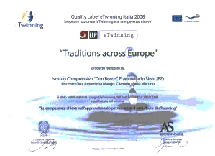Martisor Day in Romania
The first of March in Romania represents the beginning of the spring season. It is also called the Mărţişor Day because on this very day everybody receives a mărţişor, i.e. a small jewel or a small decoration tied to a red and white string. It can also be a simple mărţişor consisting of a red and a white silk thread.
The plural from mărţişor (pronounce it |mərtziſor| is mărţişoare (pronounce it |mərtziſoare| and it literally means “little/dear March”, as the Romanian word for March is Martie.
Men usually give mărţişoare to women on the 1st of March, but in our region (called Bucovina, i.e. the north-eastern Romania) and in Moldova, the neighbour region, girls give mărţişoare to boys and boys will return the favour on the 8th of March. Of course, everything is done without thinking of this as an exchange of favours.
People wear the mărţişor in March and then they hang it by a tree.
The red string of the mărţişor is the symbol of life and love, while the white string is the symbol of purity. Red also stands for spring and white for winter because the 1st of March is right between the two seasons.
The mărţişor is worn just as if it were a brooch.
The legend about our mărţişor says that there was a time when the Sun used to take the shape of a young man and descend on Earth to take part in their celebrations. A dragon found out about this and followed the Sun on Earth, captured him and locked him in his castle.
All of a sudden the birds stopped singing and the children could not laugh anymore but no one had the courage to fight the dragon.
One day, a brave young man set out to free the Sun and lots of other people joined him on the way to the dragon’s castle. The journey lasted three seasons: summer, autumn and winter. At the end of the third season, the brave young man finally reached the dragon’s castle where the Sun was imprisoned. They fought until the dragon was defeated. The brave young man managed to set the Sun free, but he was too weakened by the wounds.
Nature was alive again, people got back their smile but the brave young man could not make it through spring. His warm blood started draining from his wounds in the snow. The brave young man died, but since then people have given mărţişoare reminding everybody about his sacrifice.
Here are our 7th graders from Humoreni School making mărţişoare at school in an extra-curricular activity organized by our colleague, Mrs Ileana Nistor.
Liliana&the 6th and 7th graders


















Recent Comments